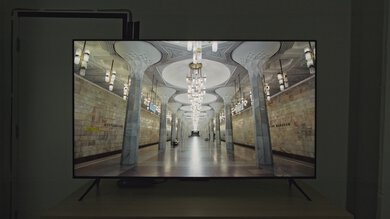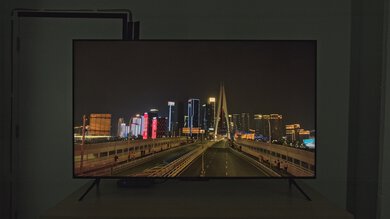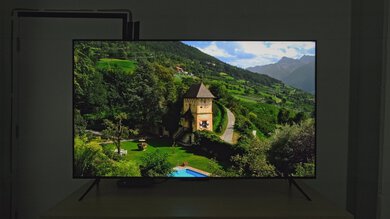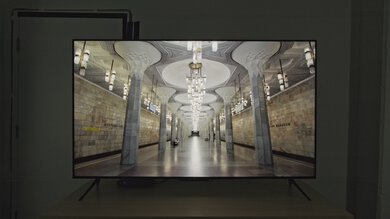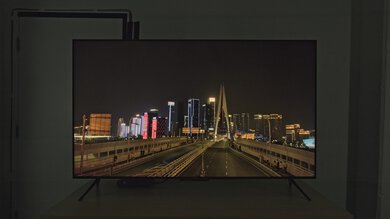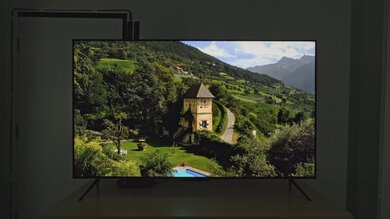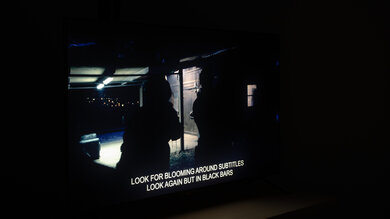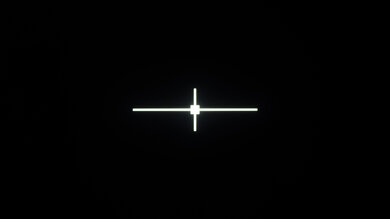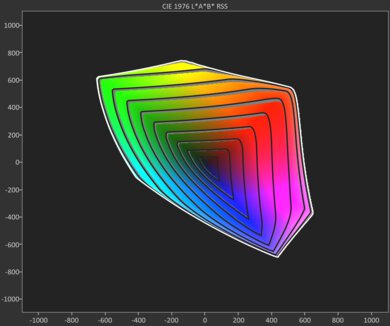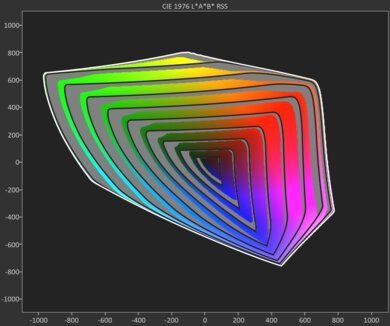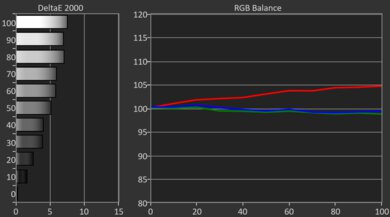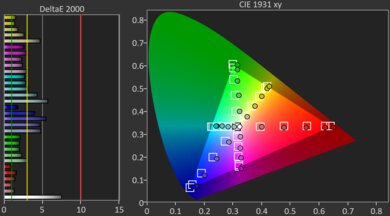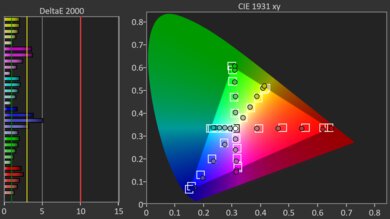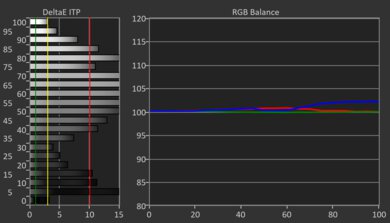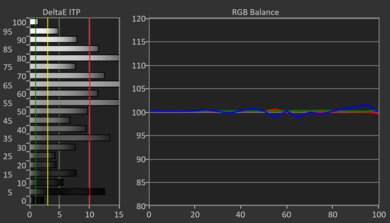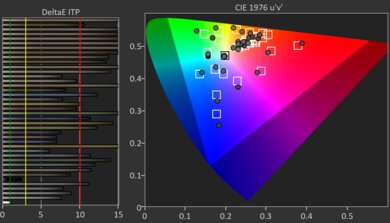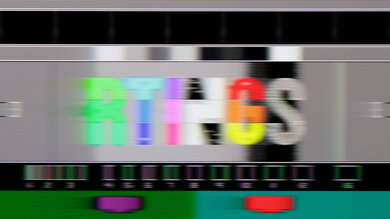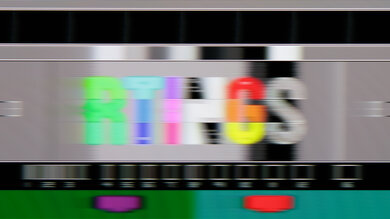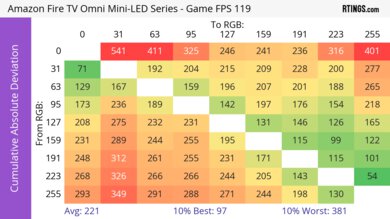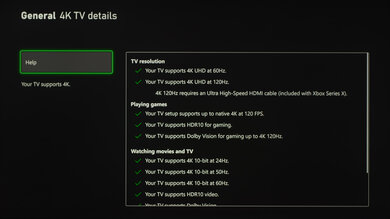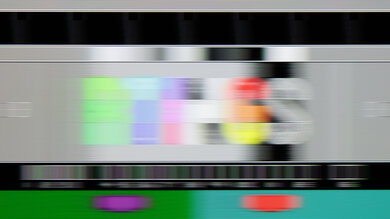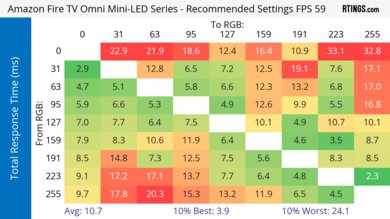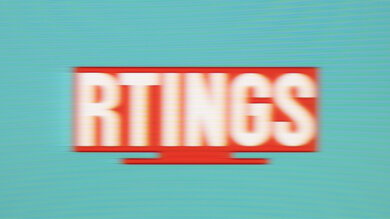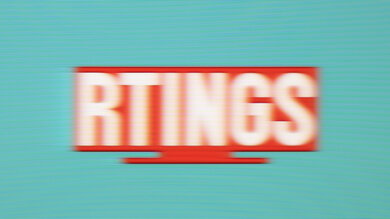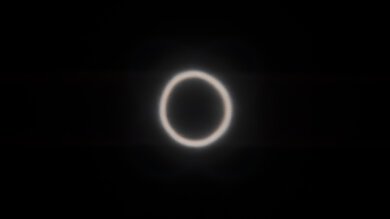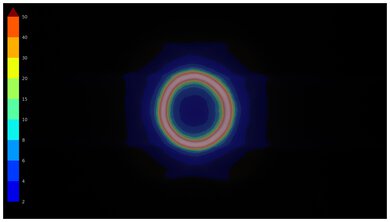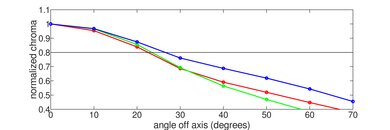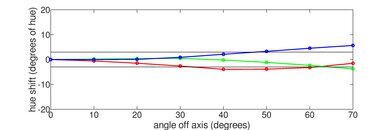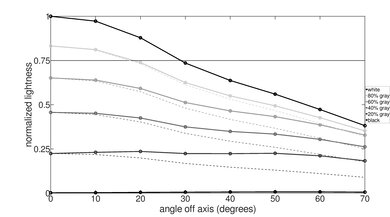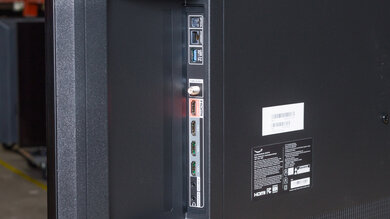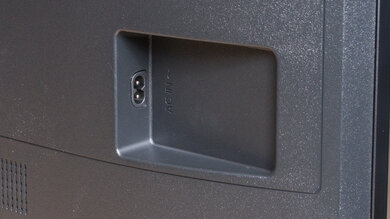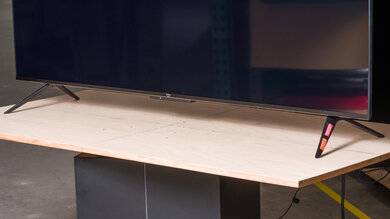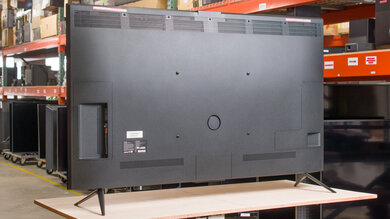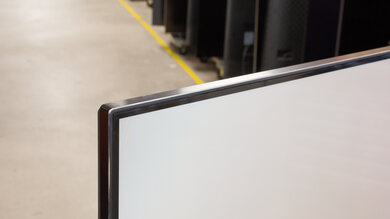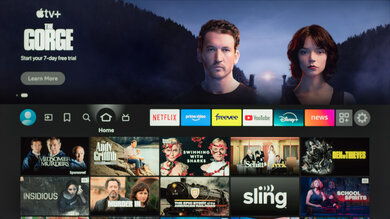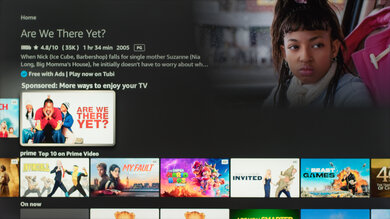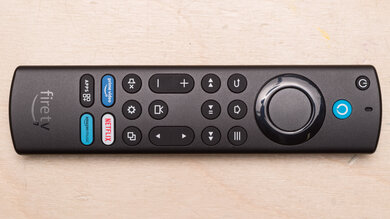The Amazon Fire TV Omni Mini-LED Series is a mid-range 4k TV in Amazon's 2024 lineup. It sits above the Amazon Fire TV Omni QLED Series, the Amazon Fire TV Omni Series, and the Amazon Fire TV 4-Series. This new model has a Mini LED panel with far more dimming zones than the preceding Omni QLED Series, giving it deeper blacks. It still has a quantum dot color filter, allowing for rich, vibrant colors, and now supports up to 4k @ 144Hz on its two HDMI 2.1 ports. It's VRR compatible, has Wi-Fi 6E connectivity, and supports advanced Dolby audio formats through eARC. It runs Amazon's Fire TV smart interface, and it supports both Dolby Vision and HDR10+. We bought and tested the 65-inch model, but it also comes in 55, 75, and 85-inch sizes.
Our Verdict
The Amazon Fire TV Omni Mini-LED is a good TV for mixed usage. It's bright, especially in SDR, so it's a viable option for use in any bright room setting, such as when watching sports. Unfortunately, due to its poor direct reflection handling, it doesn't quite excel at watching darker content in bright rooms, so horror movie fans should stick to darker rooms, especially due to the TV's truly excellent black levels. This also makes it a very good choice for movie fans, especially as its HDR color volume and HDR brightness are quite good. While its pixel transitions are rather slow, leading to some noticeable motion blur, it's still a solid choice for gamers due to its low input lag and tons of gaming features.
Low input lag, especially at 120Hz and above.
Good color volume in HDR.
Very bright TV in HDR and especially SDR.
Solid image processing when dealing with low-resolution content.
Excellent black levels deliver deep blacks in almost any context.
The TV's response time isn't quite good enough for a motion-blur free experience.
Image degrades somewhat when viewed from extreme angles.
Mediocre SDR pre-calibration accuracy.
Visible glare when placed directly opposite bright lights or windows, especially when watching darker content.
The Amazon Fire TV Omni Mini-LED is very good for use in a home theater setup. Its black levels are excellent due to its superb black uniformity, with impressive contrast that keeps blacks looking deep and dark even when bright highlights are on screen, with minimal blooming. It's also bright enough in HDR for an impactful viewing experience, especially with its good HDR color volume. Its image processing is decent, especially when it comes to upscaling low-resolution content from DVDs. It also cleans up macro-blocking from low-bitrate content well but at the cost of detail clarity. Unfortunately, there is some stutter when watching movies, but it's not excessive and isn't distracting unless you're sensitive to it.
Good color volume in HDR.
Very bright TV in HDR and especially SDR.
Solid image processing when dealing with low-resolution content.
Excellent black levels deliver deep blacks in almost any context.
Some stutter when watching movies.
Doesn't passthrough any DTS audio formats.
The Amazon Fire TV Omni Mini-LED is a good choice for a bright room, as it's easily bright enough in SDR to overcome glare. Unfortunately, its direct reflection handling is poor, so reflections are quite visible in dark scenes. Thus, stick to brighter content when watching the TV in rooms with tons of direct sources of light. Its color performance is alright in SDR content; enough for most people, although it looks slightly washed out in very bright contexts. Thankfully, it preserves its black levels quite well, no matter how bright the room is.
Very bright TV in HDR and especially SDR.
Black levels barely raise in a bright room context.
Mediocre SDR pre-calibration accuracy.
Visible glare when placed directly opposite bright lights or windows, especially when watching darker content.
The Amazon Fire TV Omni Mini-LED is a good TV for sports. Its biggest strength is its SDR brightness; it's very bright, and it overcomes glare from well-lit rooms. It's also colorful enough for your favorite jerseys to avoid looking too washed out, although as the TV's SDR color accuracy is just passable, they might look a bit off-color. It's also not the best choice for a wide seating arrangement, as its viewing angle is just mediocre. It's not bad for those sitting mostly in front, but the image quality degrades rapidly at an angle. Thankfully, the TV's image processing is decent enough to clean up any compression artifacts when watching sports through online services, and the TV is quite good at upscaling low-resolution feeds.
Very bright TV in HDR and especially SDR.
Solid image processing when dealing with low-resolution content.
Image degrades somewhat when viewed from extreme angles.
Mediocre SDR pre-calibration accuracy.
The Amazon Fire TV Omni Mini-LED is a good TV for gaming. It's pretty responsive due to its low input lag at 120Hz and 144Hz, as well as its full suite of gaming features. Unfortunately, its pixel transitions are inconsistent: fast in a few transitions but slow in most others, leading to noticeable motion blur in many scenes. Thankfully, its image quality is great overall, as it's bright and colorful enough in HDR to deliver a solid viewing experience, especially with its excellent black levels.
Low input lag, especially at 120Hz and above.
Good color volume in HDR.
Very bright TV in HDR and especially SDR.
HDMI 2.1 bandwidth, up to 4k @ 144Hz, and VRR support.
Excellent black levels deliver deep blacks in almost any context.
The TV's response time isn't quite good enough for a motion-blur free experience.
The Amazon Fire TV Omni Mini-LED's brightness is very good. It's especially bright in SDR content, as it's bright enough to overcome glare in well-lit rooms. It's no slouch in HDR, as it's good enough to make most highlights pop.
Very bright TV in HDR and especially SDR.
The Amazon Fire TV Omni Mini-LED's black level is excellent. Its black uniformity is superb, as it's nearly perfect with local dimming enabled. Its contrast is impressive, leading to very deep blacks no matter the scene, with minimal blooming.
Excellent black levels deliver deep blacks in almost any context.
Black levels barely raise in a bright room context.
The Amazon Fire TV Omni Mini-LED's color performance is decent. It's at its best in HDR content, where its color volume is good enough to deliver a colorful viewing experience. Unfortunately, it's not quite as good in SDR, but it's alright. The TV's HDR accuracy is decent as well, although it's only passable in SDR; purists will want to calibrate this TV for the best possible experience.
Good color volume in HDR.
Mediocre SDR pre-calibration accuracy.
Note: We're in the process of improving our tests related to image processing, but this score should give you a general idea of how a TV performs overall with its image processing capabilities.
The Amazon Fire TV Omni Mini-LED has satisfactory image processing. It's most impressive when upscaling low-resolution content, like from DVDs. It's also decent at removing macro-blocking from compressed content, but it does so at the cost of detail clarity. Its HDR brightness accuracy is decent, but it doesn't quite respect the content creator's intent, as most scenes are slightly too bright. There's also some noticeable banding in some HDR gradients, but it won't bother most people.
Solid image processing when dealing with low-resolution content.
The Amazon Fire TV Omni Mini-LED's game mode responsiveness is good. Its input lag is very low at 120Hz and 144Hz, leading to a very responsive gaming experience, especially as it supports all VRR technologies for a nearly tear-free experience. Unfortunately, its pixel transitions are inconsistent: fast in some transitions but slow in most others, leading to some noticeable motion blur in many scenes.
Low input lag, especially at 120Hz and above.
HDMI 2.1 bandwidth, up to 4k @ 144Hz, and VRR support.
The TV's response time isn't quite good enough for a motion-blur free experience.
We're in the process of fixing the way we evaluate a TV's overall motion handling. This section is currently broken, and the score isn't indicative of how well a TV handles motion overall.
Performance Usages
Changelog
-
Updated Aug 18, 2025:
We bought and tested the Panasonic W70B, and added a mention in the Popular TV Comparisons section.
-
Updated May 23, 2025:
We mentioned the newly reviewed Hisense U8QG in the Total Reflected Light section.
- Updated May 08, 2025: Converted to Test Bench 2.0.1. We did this to fix an issue with our scoring in the Supported Resolutions section, since TVs with a refresh rate higher than 144Hz were being penalized for not supporting 144Hz.
- Updated Mar 31, 2025: Review published.
Check Price
Differences Between Sizes And Variants
We tested the 65-inch Amazon Fire TV Omni Mini-LED Series, and our results are also valid for the 55, 75, and 85-inch models. The only difference between sizes is the number of dimming zones. There are no other variants of this TV.
| Size | SKU number (U.S.) | Local Dimming Zones |
|---|---|---|
| 55" | ML55F700 | 512 |
| 65" | ML65F700 | 768 |
| 75" | ML75F700 | 960 |
| 85" | ML85F700 | 1344 |
See our product's label.
Popular TV Comparisons
The Amazon Fire TV Omni Mini-LED Series is a good TV overall, with no real weaknesses perhaps outside of its color accuracy, SDR color volume, and rather uneven pixel transitions. As good as it is, it's outpriced and outperformed by the Hisense U7N and the TCL QM7/QM751G QLED, with the TCL being an especially good buy due to its higher peak brightness, more colorful display, and faster gaming performance. Still, the Amazon is worth keeping in mind, especially as it might get some severe price cuts during Amazon's numerous yearly sales. It's also a good choice if you're fully invested in Amazon's ecosystem, as it's far better than the most of the other TVs powered by Fire TV, including the Panasonic W70B.
For more options, check out our recommendations for the best TVs, the best QLED TVs, and the best 4k gaming TVs.
The Amazon Fire TV Omni Mini-LED Series is better than the TCL QM6K. The Amazon delivers a more impactful viewing experience due to its far brighter HDR and SDR image, alongside a slightly better local dimming feature with less blooming around bright highlights. Still, the TCL is the most accurate TV of the two. It's also slightly better for gaming due to its up to 1080p @ 288Hz support with TCL's Game Accelerator feature, with slightly lower input lag than the Amazon.
The Amazon Fire TV Omni Mini-LED Series is better than the Amazon Fire TV Omni QLED Series 2022. The Mini-LED has far deeper contrast and gets much brighter in HDR and SDR, giving it a much more impactful viewing experience overall. It's also far better for gamers due to its up to 4k @ 144Hz support and wide VRR range, while the Omni QLED Series 2022 caps out at 4k @ 60Hz.
The Hisense U7N and the Amazon Fire TV Omni Mini-LED Series trade blows, but they're overall quite similar. The Hisense is a bit better in brighter rooms due to its better reflection handling. Inversely, the Amazon has the edge in darker rooms or reference conditions due to its far better black levels, with deeper contrast and a better local dimming solution. Purists will appreciate the slightly more accurate Hisense, as it respects the content creator's intent a bit more.
The Roku Pro Series and the Amazon Fire TV Omni Mini-LED Series are similar TVs, but the Amazon has a slight edge overall. The Roku is slightly brighter, but the Amazon has better black levels overall, making it look a bit better in darker rooms. Plus, the Amazon has far better image processing, so it's better for those who watch low-bitrate or low-resolution content. For gamers, the Amazon has a slight edge due to its 4k @ 144Hz support, while the Roku caps out at 4k @ 120Hz.

We buy and test dozens of TVs yearly, taking an objective, data-driven approach to deliver results you can trust. Our testing process is complex, with hundreds of individual tests that take over a week to complete. Most of our tests are done with specially designed test patterns that mimic real content, but we also use the same sources you have at home to ensure our results match the real-world experience. We use two main tools for our testing: a Colorimetry Research CR-100 colorimeter and a CR-250 spectroradiometer.
Test Results

The Amazon Fire TV Omni Mini-LED has good HDR brightness, so highlights stand out during darker scenes, especially combined with its impressive contrast.
Results with HDR Tone Mapping set to 'On':
- Hallway Lights: 576 cd/m²
- Yellow Skyscraper: 385 cd/m²
- Landscape Pool: 253 cd/m²
The TV is brighter in Game Mode but at the cost of noticeably less accurate colors.
Results with HDR Tone Mapping set to 'On':
- Hallway Lights: 623 cd/m²
- Yellow Skyscraper: 408 cd/m²
- Landscape Pool: 347.3 cd/m²
The TV has great SDR brightness, enough to overcome glare in very bright rooms.
The TV has decent lighting zone transitions. Still, there is some visible darkening on the leading edge of bright objects, with noticeable haloing.
The TV has superb black uniformity. Even with local dimming disabled, there is barely any clouding, although there is some if you look extremely closely. With local dimming enabled, the TV's black uniformity is almost perfect, with minimal blooming around bright highlights.
The TV has decent SDR color volume overall, but barely. It lacks the color volume in DCI-P3 to fully display any color, but it's good overall. However, the TV's color volume is middling in the BT.2020 color space; it struggles with fully displaying almost all colors, and it's again worse with lighter ones.
| Volume ΔE³ | DCI-P3 Coverage |
BT.2020 Coverage |
|---|---|---|
| L10 | 90.15% | 64.68% |
| L20 | 90.78% | 63.36% |
| L30 | 90.91% | 63.88% |
| L40 | 90.09% | 64.81% |
| L50 | 89.23% | 65.63% |
| L60 | 86.78% | 62.72% |
| L70 | 82.68% | 53.28% |
| L80 | 81.74% | 50.40% |
| L90 | 81.88% | 50.40% |
| L100 | 86.63% | 56.97% |
| Total | 85.99% | 58.24% |
The TV has good HDR color volume. Dark saturated colors are displayed well due to the TV's impressive contrast. The TV displays some colors at high luminance levels, and it excels at displaying bright whites, but it does struggle a bit with yellows, cyans, and especially greens.
The Amazon Fire TV Omni Mini-LED has unremarkable SDR pre-calibration accuracy. There's too much red in all grays, and the brighter the grays, the more red there is. Inversely, blues and greens are slightly underrepresented in brighter grays, making the TV's color temperature noticeably too warm. Its color accuracy is good; however, with most colors being mostly on target, there are some color mapping issues in lighter yellows, cyans, whites, and most blues.
The TV's SDR image accuracy is fantastic after calibration. White balance is now almost perfect, and color temperature is right on the 6500K target. Color accuracy is great, even if there are still some color mapping issues with blues and magentas.
You can see our full calibration settings.
The Amazon Fire TV Omni Mini-LED's HDR pre-calibration accuracy is decent. Blues are overrepresented in brighter grays and reds in mid-grays, making the TV's color temperature slightly too cold overall. Color accuracy is decent, but there are noticeable deviations in most colors.
The TV's HDR accuracy after calibration is good. The biggest change from its pre-calibration state is its now fantastic color temperature, which is far closer to our target of 6500K. White balance is also slightly improved, although color accuracy is more or less unchanged.
The TV has decent PQ EOTF tracking. All content outside of very dark shadows is too bright, however, so it doesn't fully respect the content creator's intent. There's a roll-off near the TV's peak brightness to maintain details in highlights in all mastered content.
The TV's HDR native gradient handling is alright. There's very noticeable banding in dark grays, with some slightly less visible banding in brighter grays and darker reds, as well as in all greens.
The TV has low input lag, especially at 120Hz, when set to Game Mode. Unfortunately, chroma 4:4:4 is unavailable in Game Mode. Our 4:4:4 measurement was taken in the 'Movie bright' Picture Mode.
The TV supports all common resolutions up to 4k @ 144Hz on two of its four HDMI ports. Unfortunately, it doesn't display chroma 4:4:4 while in Game Mode.
The Amazon Fire TV Omni Mini-LED supports all three VRR formats, so it has great compatibility regardless of the source.
The TV has okay CAD at its maximum refresh rate of 144Hz. It struggles most when going from bright shades to very dark ones, and although it performs a bit better going from dark shades to brighter ones, it's still pretty slow. This leads to noticeable blur behind quick motion.
The Amazon Fire TV Omni Mini-LED Series is fully compatible with everything the PS5 offers, like 1440p @ 120Hz and 4k @ 120Hz, as well as HDMI Forum VRR. It also supports Auto Low Latency Mode, so you don't have to worry about switching to Game Mode to get the lowest input lag.
The TV is almost fully compatible with everything the Xbox Series X|S offers, such as 4k @ 120Hz, HDMI Forum VRR, FreeSync Premium Pro, and Dolby Vision gaming. Unfortunately, it only supports 1440p on the Xbox when forced through the HDMI override setting, which also disables all gaming features, limiting its usefulness. It does support Auto Low Latency Mode, so you don't have to worry about manually switching to Game Mode to get the lowest input lag.
There's some noticeable stutter when watching movies or TV shows that's most apparent in slow panning shots, but it's not too bad.
The Amazon Fire TV Omni Mini-LED Series automatically removes judder from 24Hz sources and the internal apps. To remove judder from 60p and 60i sources, like a cable box, you must enable the Natural Cinema setting.
The TV has a good response time overall, but it's very slow in many transitions, especially when going from a completely dark state to a brighter one. This makes for a rather uneven performance, as some scenes look clean, while others look blurry.
This TV doesn't have an optional backlight strobing feature, commonly known as black frame insertion (BFI).
This Amazon Fire TV Omni Mini-LED Series has an optional motion interpolation feature to improve the clarity of motion, but it doesn't work very well. Even slower-moving scenes have some noticeable artifacts. The TV really struggles in faster-moving scenes, and there are distracting artifacts and haloing.
Note that motion interpolation is unavailable when watching any content in Dolby Vision.
The Amazon Fire TV Omni Mini-LED has poor direct reflection handling. It barely reduces the intensity of direct light sources like a lamp placed opposite the screen, which is very distracting.
Black levels barely raise on this TV in a room with ambient lighting, so you still get deep blacks regardless of your lighting conditions.
The total reflected light of this TV is mediocre. Reflections are noticeable during dark scenes, and there's some distracting light banding. You can get much better reflection handling from a Mini LED TV like the Hisense U8QG.
The TV has decent color saturation in a bright room. Still, there's some color degradation in well-lit contexts.
The TV has a mediocre viewing angle, so it's not suitable for a wide seating arrangement. Its biggest weaknesses are its gamma shifting and raised black levels at an angle, so colors look off and washed out as you move further away to the sides.
The TV has okay gray uniformity, but there's some dirty screen effect towards the center of the screen, and the corners and sides are a bit darker than the center. Its uniformity is a bit worse on a very dark or near-black screen, as the sides of the screen are visibly cloudy when compared to the center.
The TV uses a BGR (Blue-Green-Red) subpixel layout instead of the traditional RGB layout. For video or gaming content, this doesn't cause any issues, but for PC monitor use, it can be a problem as it impacts the text clarity, although not everyone will notice this.
The TV uses a KSF phosphor coating to produce red light, with high peaks on reds and blues. This model does have good separation between colors, giving it solid color purity and a wide color gamut.
The TV has HDMI 2.1 bandwidth on HDMI ports 1 and 2, with both supporting up to 4k @ 144Hz. Unfortunately, the HDMI 1 port is also the eARC port, so you lose a high bandwidth port when you plug a soundbar into the TV. The TV supports both Dolby Vision and HDR10+. Unfortunately, the tuner is limited to ATSC 1.0, so you can't stream 4k content over the air.
The TV supports eARC, which lets you pass high-quality, uncompressed audio to a compatible receiver or soundbar through an HDMI cable. Unfortunately, it doesn't support DTS audio formats commonly used on Blu-rays.
The back of the TV is made of plastic. All of the inputs except for the power connector are located on the right side of the TV when facing the front, and they're easy to access if you have the TV wall-mounted. Unfortunately, there's no form of cable management.
The TV has an okay frequency response, with no obvious weaknesses. Like many TVs, its bass isn't great, but it's alright, especially for a TV. The sound is clear enough to make dialogue easy to understand, and there aren't too many pumping artifacts at high volume, although the TV doesn't get very loud.

